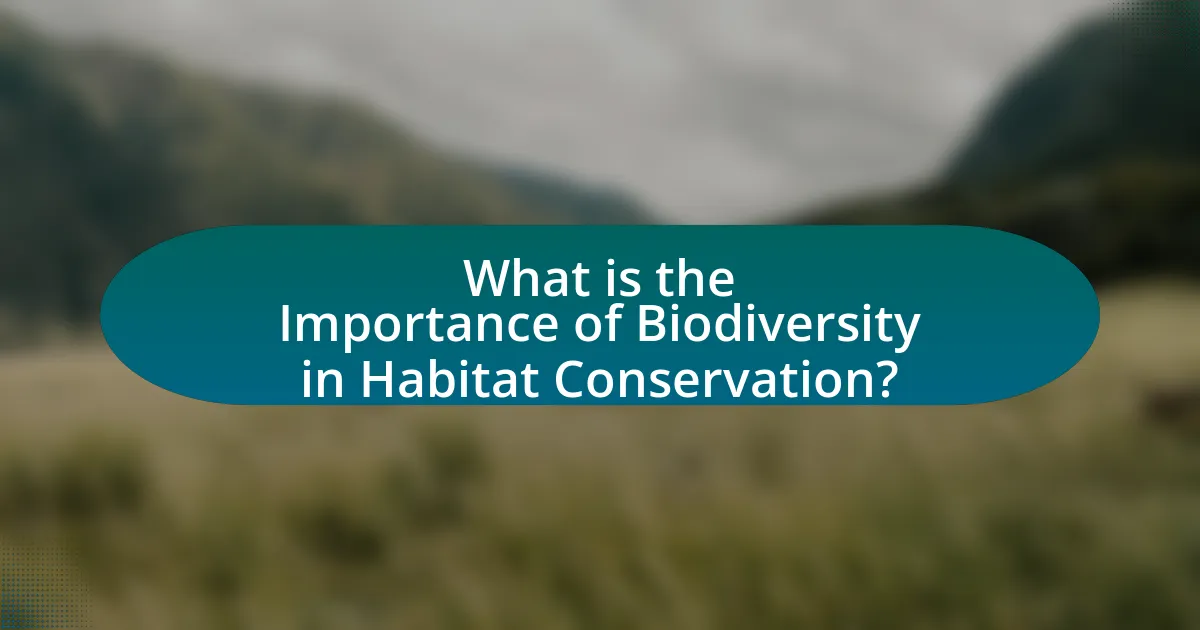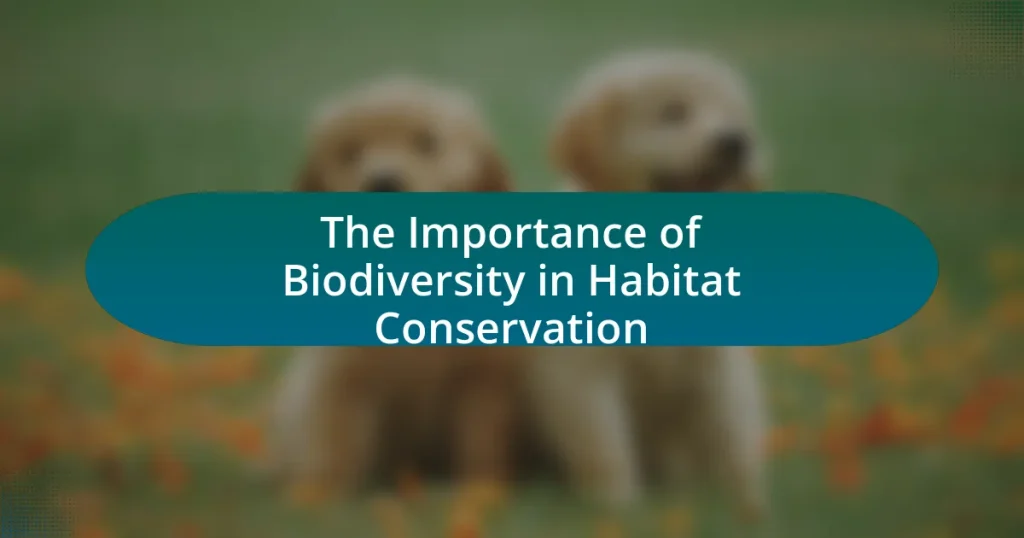Biodiversity is a critical component of habitat conservation, enhancing ecosystem resilience, stability, and productivity. Diverse ecosystems are better equipped to withstand environmental changes and disturbances, which is essential for maintaining vital ecosystem services such as clean water and pollination. The article explores the roles different species play in maintaining ecosystem balance, the impact of biodiversity loss on habitat stability, and the key threats to biodiversity, including human activities and climate change. It also discusses effective strategies for promoting biodiversity in conservation efforts, the importance of community involvement, and the role of policy and legislation in supporting biodiversity initiatives.

What is the Importance of Biodiversity in Habitat Conservation?
Biodiversity is crucial for habitat conservation as it enhances ecosystem resilience, stability, and productivity. Diverse ecosystems can better withstand environmental changes and disturbances, such as climate change and habitat destruction. For instance, a study published in the journal “Nature” found that ecosystems with higher species diversity are more productive and can recover more quickly from disturbances. This resilience is vital for maintaining ecosystem services, such as clean water, pollination, and carbon storage, which are essential for human survival and well-being. Therefore, preserving biodiversity directly supports the health and sustainability of habitats.
Why is biodiversity crucial for ecosystem health?
Biodiversity is crucial for ecosystem health because it enhances resilience, stability, and productivity of ecosystems. Diverse species contribute to various ecological functions, such as nutrient cycling, pollination, and pest control, which are essential for maintaining ecosystem balance. For instance, ecosystems with higher species diversity are better able to withstand environmental stressors, such as climate change and disease outbreaks, as evidenced by studies showing that diverse plant communities can recover more quickly from disturbances compared to monocultures. This relationship underscores the importance of biodiversity in sustaining ecosystem services that are vital for human survival and well-being.
What roles do different species play in maintaining ecosystem balance?
Different species play crucial roles in maintaining ecosystem balance through various interactions that support biodiversity and ecological stability. For instance, producers like plants convert sunlight into energy, forming the base of the food web, while consumers, such as herbivores and carnivores, regulate population sizes and contribute to nutrient cycling. Decomposers, including fungi and bacteria, break down organic matter, returning essential nutrients to the soil, which supports plant growth. This interconnectedness ensures that ecosystems function effectively, as evidenced by studies showing that ecosystems with higher biodiversity are more resilient to disturbances, such as climate change and invasive species. For example, a study published in “Nature” by Cardinale et al. (2012) found that biodiversity loss can lead to decreased ecosystem productivity and stability, highlighting the importance of each species in maintaining ecological balance.
How does biodiversity contribute to resilience against environmental changes?
Biodiversity enhances resilience against environmental changes by providing a variety of species that can adapt to shifting conditions. This diversity ensures ecosystem stability, as different species fulfill various ecological roles, allowing ecosystems to maintain functionality despite disturbances. For instance, ecosystems with high biodiversity can recover more quickly from events like droughts or floods, as seen in studies showing that diverse plant communities are better at retaining soil moisture and nutrients. Additionally, genetic diversity within species increases the likelihood that some individuals will survive and reproduce under changing environmental conditions, further supporting ecosystem resilience.
How does biodiversity impact habitat conservation efforts?
Biodiversity significantly enhances habitat conservation efforts by maintaining ecosystem resilience and functionality. Diverse ecosystems are better equipped to withstand environmental changes, such as climate fluctuations and invasive species, which can threaten habitat integrity. For instance, a study published in the journal “Nature” found that ecosystems with higher species diversity are more productive and stable, leading to improved conservation outcomes. This stability allows for more effective management of habitats, as diverse species contribute to various ecological processes, such as nutrient cycling and pollination, which are essential for sustaining healthy environments.
What are the direct benefits of preserving diverse species in habitats?
Preserving diverse species in habitats directly benefits ecosystems by enhancing resilience, promoting stability, and supporting ecosystem services. Diverse species contribute to nutrient cycling, pollination, and pest control, which are essential for maintaining healthy environments. For instance, a study published in the journal “Nature” found that ecosystems with higher species diversity are more productive and better able to withstand environmental stressors, such as climate change and disease outbreaks. This evidence underscores the critical role that biodiversity plays in sustaining the ecological balance and ensuring the availability of resources for future generations.
How does loss of biodiversity affect habitat stability and integrity?
Loss of biodiversity negatively impacts habitat stability and integrity by reducing ecosystem resilience and functionality. When species diversity declines, ecosystems become more vulnerable to disturbances such as climate change, invasive species, and diseases, leading to a breakdown in ecological processes. For instance, a study published in the journal “Nature” found that ecosystems with higher biodiversity are better able to withstand environmental stressors, maintaining their structure and function. This evidence highlights that diverse habitats are crucial for sustaining ecological balance and ensuring long-term habitat integrity.
What are the key threats to biodiversity in habitats?
Key threats to biodiversity in habitats include habitat destruction, climate change, pollution, invasive species, and overexploitation. Habitat destruction, primarily due to urbanization and agriculture, leads to loss of ecosystems and species. Climate change alters temperature and precipitation patterns, affecting species survival and distribution. Pollution, including plastic waste and chemical runoff, degrades habitats and harms wildlife. Invasive species outcompete native species for resources, disrupting local ecosystems. Overexploitation of resources, such as overfishing and deforestation, further diminishes biodiversity. These factors collectively threaten the stability and resilience of ecosystems, as evidenced by the ongoing decline in species populations globally.
How do human activities contribute to biodiversity loss?
Human activities contribute to biodiversity loss primarily through habitat destruction, pollution, overexploitation, and climate change. Habitat destruction, such as deforestation and urbanization, leads to the fragmentation and loss of ecosystems, which directly reduces species populations and their genetic diversity. For instance, the World Wildlife Fund reports that approximately 1 million species are at risk of extinction due to habitat loss. Pollution from agricultural runoff and industrial waste contaminates ecosystems, harming species and disrupting food chains. Overexploitation of resources, including overfishing and poaching, depletes populations faster than they can recover, threatening their survival. Additionally, climate change alters habitats and species distributions, further exacerbating the decline in biodiversity. According to the Intergovernmental Science-Policy Platform on Biodiversity and Ecosystem Services, human-induced climate change is a significant driver of biodiversity loss, affecting ecosystems globally.
What role does climate change play in threatening biodiversity?
Climate change significantly threatens biodiversity by altering habitats, disrupting ecosystems, and increasing extinction rates. Rising temperatures and changing precipitation patterns lead to habitat loss, as species struggle to adapt to new conditions. For instance, a study published in “Nature” by Thomas et al. (2004) estimates that climate change could drive 15-37% of species to extinction if global temperatures rise by 2°C. Additionally, ocean acidification and warming threaten marine biodiversity, impacting coral reefs and fish populations. These changes create a cascade effect, disrupting food webs and ecological balance, further endangering various species.
How can we enhance biodiversity in habitat conservation?
Enhancing biodiversity in habitat conservation can be achieved through the implementation of habitat restoration, protection of existing ecosystems, and sustainable land-use practices. Habitat restoration involves rehabilitating degraded areas to support native species, which has been shown to increase species richness and ecosystem resilience. For instance, a study published in “Ecological Applications” by Suding et al. (2015) demonstrated that restored habitats can recover up to 80% of their original biodiversity. Protecting existing ecosystems, such as wetlands and forests, prevents habitat loss and fragmentation, which are critical threats to biodiversity. Additionally, sustainable land-use practices, including agroforestry and organic farming, promote biodiversity by maintaining diverse plant and animal communities. Research indicates that these practices can enhance local biodiversity by up to 30% compared to conventional methods, as noted in a report by the Food and Agriculture Organization (FAO).
What strategies are effective in promoting biodiversity in conservation areas?
Effective strategies for promoting biodiversity in conservation areas include habitat restoration, sustainable land management, and the establishment of protected areas. Habitat restoration enhances ecosystem functionality by reintroducing native species and removing invasive ones, which has been shown to increase species richness and abundance. Sustainable land management practices, such as agroecology and responsible forestry, help maintain ecological balance while allowing for human use of resources, thereby supporting both biodiversity and livelihoods. The establishment of protected areas, as evidenced by the IUCN’s World Database on Protected Areas, has been crucial in safeguarding habitats and species from human encroachment, leading to significant increases in biodiversity within these zones.
How can community involvement support biodiversity initiatives?
Community involvement can significantly support biodiversity initiatives by fostering local stewardship and enhancing conservation efforts. Engaged communities often participate in habitat restoration projects, which can lead to increased native species populations and improved ecosystem health. For instance, studies have shown that community-led initiatives, such as tree planting and invasive species removal, can result in a 30% increase in local biodiversity within a few years. Furthermore, when communities are involved, they are more likely to advocate for sustainable practices and policies, ensuring long-term protection of biodiversity. This active participation not only empowers individuals but also creates a collective responsibility towards preserving natural habitats, ultimately benefiting both the environment and the community.
What are the best practices for integrating biodiversity into habitat conservation plans?
The best practices for integrating biodiversity into habitat conservation plans include conducting comprehensive biodiversity assessments, engaging stakeholders, and implementing adaptive management strategies. Comprehensive biodiversity assessments identify species and ecosystems present in the area, allowing for targeted conservation efforts. Engaging stakeholders, including local communities and experts, ensures that diverse perspectives are considered, fostering collaboration and support for conservation initiatives. Adaptive management strategies allow for ongoing monitoring and adjustments based on ecological changes and new scientific data, enhancing the effectiveness of conservation efforts. These practices are supported by research indicating that inclusive and informed approaches lead to more successful biodiversity outcomes in conservation planning.
How can monitoring and assessment improve biodiversity outcomes?
Monitoring and assessment can significantly improve biodiversity outcomes by providing data that informs conservation strategies and management practices. By systematically tracking species populations, habitat conditions, and ecological interactions, stakeholders can identify trends, threats, and opportunities for intervention. For instance, a study published in “Biodiversity and Conservation” by Lindenmayer and Likens (2010) highlights that regular monitoring enables timely responses to environmental changes, such as habitat degradation or invasive species, thereby enhancing the effectiveness of conservation efforts. Furthermore, assessment tools like biodiversity indices allow for the evaluation of ecosystem health, guiding resource allocation and policy decisions that promote biodiversity preservation.
What role do policy and legislation play in supporting biodiversity conservation?
Policy and legislation are crucial in supporting biodiversity conservation by establishing legal frameworks that protect ecosystems and species. These regulations, such as the Endangered Species Act in the United States, provide mechanisms for habitat protection, species recovery plans, and penalties for violations, thereby ensuring that biodiversity is prioritized in land-use decisions. Furthermore, international agreements like the Convention on Biological Diversity set global targets for conservation efforts, guiding national policies and fostering cooperation among countries. Such policies are essential for mitigating threats to biodiversity, as they create accountability and promote sustainable practices that benefit both the environment and human communities.
What practical steps can individuals take to support biodiversity in their local habitats?
Individuals can support biodiversity in their local habitats by creating native plant gardens, which provide essential food and shelter for local wildlife. Native plants are adapted to the local environment and require less water and maintenance, promoting a sustainable ecosystem. Additionally, individuals can reduce pesticide use, as chemicals can harm beneficial insects and disrupt food chains. Engaging in community clean-up efforts helps maintain healthy habitats by removing litter that can harm wildlife. Supporting local conservation organizations through volunteering or donations also contributes to broader biodiversity initiatives. According to the National Wildlife Federation, native plants can support up to 50% more wildlife than non-native species, highlighting the effectiveness of these actions in enhancing local biodiversity.


